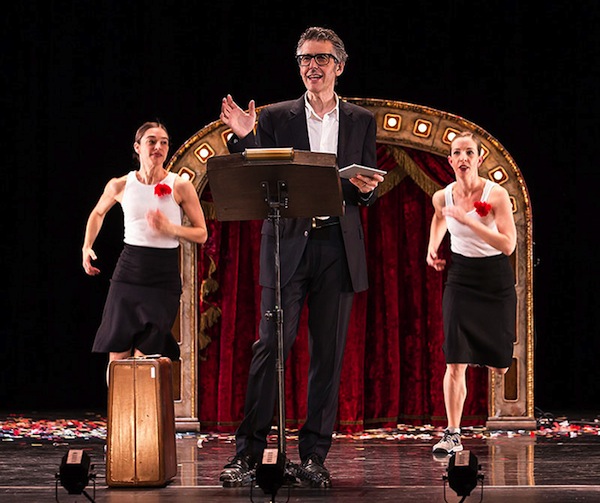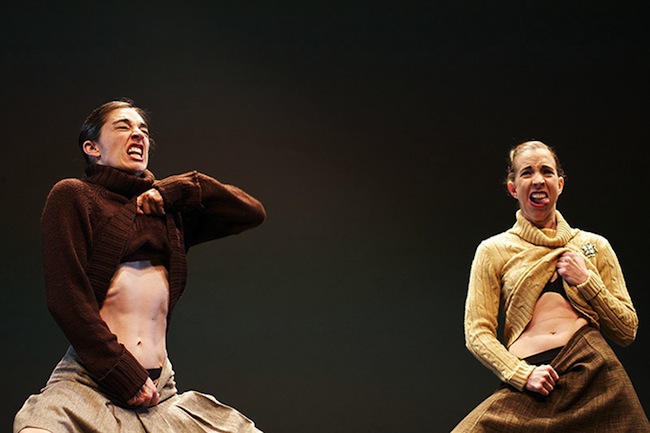Dance Preview: Radio Dancing — A Conversation with Monica Bill Barnes
Monica Bill Barnes’s choreographic method can be characterized as make ’em laugh, then make ’em think.
Ira Glass, Monica Bill Barnes, and Anna Bass in Three Acts, Two Dancers, One Radio Host at the Citi Shubert Theatre, Boston, MA., January 24 and 25.

Ira Glass at the podium during “Three Acts, Two Dancers, One Radio Host.”
By Debra Cash
When they buy tickets to Three Acts, Two Dancers, One Radio Host most audiences are attracted not by the dance per se but by the appearance of celebrity storyteller Ira Glass of This American Life. Glass is a guy who used to duck his face behind an open book when he had his photograph taken, because, well because, you can’t see people’s faces on the radio. Over the course of Three Acts, Two Dancers, One Radio Host by philosophy student-turned choreographer Monica Bill Barnes, they stay for the dancing, the lame circus tricks, the multiple costume changes, and — this may be a spoiler — the celebratory confetti.
Monica Bill Barnes‘s choreographic method can be characterized as make ’em laugh, then make ’em think. Three Acts is based around radio interviews restaged as dance pieces, plus stories from the lives of each of the three performers, Glass, Barnes and dancer Anna Bass. Act One is about the job of being a performer, self-doubt, authenticity and the challenge of keeping it fresh. Act Two explores the many faces of love. And in This American Life fashion, Act Three has been titled “Nothing Lasts Forever.”
Barnes established her company in 1997 “with a handful of solos she performed everywhere.” She is well aware that this self-produced project has brought her new and unusual financial stability. In a recent end of the year e-blast she announced that all her longtime collaborators: Associate Artistic Director/dancer Bass, lighting designer Jane Cox, and set and costume designer Kelly Hanson had gotten health insurance, child care, and a raise.
Three Acts has also brought MMB&CO to new venues. This fall they opened the Miami Book Fair and performed at Town Hall in Manhattan, a theatre that the performers explained is located much closer to the actual street called Broadway than the theatres currently showing Kinky Boots or Les Mis. The long multivenue tour has allowed the creative team to develop their work in the front of an audience, a tryout process that is almost never possible in the cash-strapped dance world. “I find it hilarious and amazing that there is an NPR audience in every single state, and there is an established system of marketing directly to that audience, because the radio is always on and available,” she told me during a recent phone conversation. At the end of 2014, the company’s Facebook posting marveled “Did the math and realized we performed for over 40,000 audience members this year. Wow, we are such lucky ducks.”
Ira Glass likes to say that dance is not his metier, but Three Acts is not his first outing with MBB&CO either. Back in 2012, they collaborated on a filmed This American Life variety show that was beamed into movie theatres. It was part of Glass’ ongoing effort to expand his reach beyond his mere 2+ million radio listeners and explore new media formats. Personally, I was fond of the short-lived television show, which most recently spun off the hit podcast Serial. Early in the Three Acts run he admitted that he’d gone to the gym and lost 30 pounds to prep, but mostly each artist does what he or she does best. He talks. They dance. Everyone has stories to share. And no one in the audience has to sit in the driveway with the motor running to experience the show all the way to the end.
Barnes says she has a special place in her heart for Boston audiences — and she assures me that she doesn’t say a version of this to everyone who interviews her. When World Music/CRASHArts presented MMB&CO in the smaller venue of the ICA, she was impressed by the ways the local audience seemed to get the subtlest jokes, and by their insights during the post show questions and answer sessions.
Elements from Barnes’s repertory pieces Another Parade and Everything is Getting Better All the Time are threaded through Three Acts. These are comic dances, but also dances of social awkwardness and lay-your-heart-on-the-line poignancy, including an episode based on an interview with New England poet Donald Hall about the untimely death of his wife Jane Kenyon. (It’s safe to say that the Boston audience will be more familiar with Hall’s work than many others have been.)

A scene featuring Monica Bill Barnes and Anna Bass in “Three Acts, Two Dancers, One Radio Host.”
“I love making dances and being of the dance world, but at the same time I wondered if being contextualized as dance is always the best frame for viewing my work,” Barnes says. “In everything I’ve done design-wise with my collaborators since grad school, the lighting, the music, the costumes, I’m trying to create an unexpected frame for viewing dance. In a way I feel it was a natural extension for me to think about how else I could contextualize my work. I wanted to know if my work were framed differently, how would that affect the audiences that came into the theatre?”
“In the beginning of the show, Anna and I function as backup dancers, with a story about Riverdance and the repetitiveness of the job, what it is to dream to be a dancer versus having that dream come true and turn into doing the same thing for eight shows a week. In that section we’re not individualistic, interesting performers, because I felt there was no point in beginning the show saying “this is Anna and me and we’re really important and special too!” We want to meet the audience where they are. Act Two starts to take a personal turn, and truly it’s not until Act Three that we’ve built a genuine connection. There’s no sense of wanting to be top dog, and it’s such a wonderful experiment.
“Ira’s well known so why not embrace it? In person, he is so akin to a stand-up comic in the way that he’s reading an audience. He’s so darn good, but I’ll say that, it is part of his charm that he comes across in an unassuming way. It’s theatrical slight-of-hand.
“One thing that has been so amazing to me is to have the invitation to perform on these huge stages in front of large audiences. We have to adjust our performances. The scale has been an interesting opportunity to just do less and to rely on the strength of the ideas to carry us through.”
It’s great to be able to draw on the Ira Glass Fan Club, but will Three Acts translate into new audiences for modern dance? Monica Bill Barnes is honest: she doesn’t know.
“I’ve heard both sides of the equation, that this work advocates for dance as an art form, and then other people say well, as soon as you have language, dance is secondary. In some ways both are true. I wish I knew what it took for someone who didn’t study dance, who isn’t related to a dancer, who doesn’t have a child in a recital to go to dance, I wish I knew what motivated people, but I don’t. I’d hope they’d see the local dance company that performs twice a year in the same theatre, but I feel as artists, our job is just to make the show and hope for the best.”
Debra Cash has reported, taught and lectured on dance, performing arts, design and cultural policy for print, broadcast and internet media. She regularly presents pre-concert talks, writes program notes and moderates events sponsored by World Music/CRASHarts and cultural venues throughout New England. A former Boston Globe and WBUR dance critic, she is a two-time winner of the Creative Arts Award for poetry from the Hadassah-Brandeis Institute and will return to the 2015 Bates Dance Festival as Scholar in Residence.
c Debra Cash 2015
Tagged: Anna Bass, Boston's Celebrity Series, Ira Glass, Monica Bill Barnes
